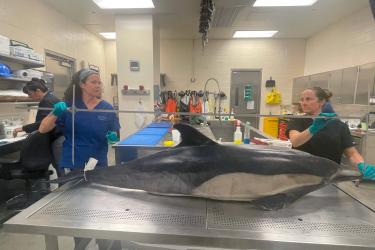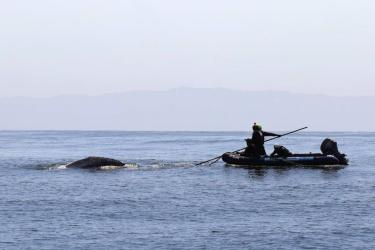Salmon and steelhead in Northern California have been in trouble for more than 100 years, primarily because of habitat damage and loss resulting from human activities. Climate change has only worsened these habitat problems. For the last 50 years, communities have worked to restore this habitat in hopes of reversing the fortunes of these fish. Scientists and local restoration communities are seeking new ways to maximize the benefits of habitat restoration so that rivers and streams can support healthy fish populations again.
One new approach to maximize these benefits is the Salmonid Habitat Restoration Priorities (SHaRP) process. The process creates a strategy to rebuild salmon and steelhead within a watershed by focusing on restoring its healthier, less impaired areas. Scientists expect that improved fish survival and reproduction in these restored areas will enable faster recolonization of the more degraded areas.
“The SHaRP process builds upon existing recovery plans and identifies very specific actions to create real wins for declining species. This approach to conservation offers the restoration community a seat at the table to design a near-term recovery strategy to maximize restoration impacts for their watershed,” said Barry Thom, NOAA Fisheries West Coast Regional Administrator.
NOAA Fisheries and the California Department of Fish and Wildlife (CDFW) developed the SHaRP process. They first applied it to the South Fork Eel River, a few hours drive north of San Francisco Bay. Historically, the Eel River supported hundreds of thousands of Chinook salmon, coho salmon, and steelhead. Today, these three species reflect only about 5 percent of their historical numbers.
The Need for SHaRP
In the mid-1990s, California’s coho salmon, Chinook salmon, and steelhead were listed under state and federal endangered species acts. NOAA Fisheries and CDFW developed separate recovery plans to identify the numerous short- and long-term actions needed to rebuild each species. These recovery plans are broad in scope and scale. They need further consideration to identify, prioritize, plan, and implement habitat restoration at the project and stream-reach scale.
That’s where the SHaRP process comes in. It builds upon the restoration actions described in recovery plans by pulling from local knowledge. This results in a targeted, site-specific, and scientifically-sound restoration strategy that focuses dollars and effort on locations that will have the most impact.
How SHaRP Works
The process starts by identifying the focus areas within an overall watershed that have the highest potential to support healthy salmon and steelhead. Local experts in each focus area then come together to evaluate the challenges facing each life stage of each species of salmon and steelhead. They then agree upon the best restoration solutions to these challenges. Action plans are developed for each focus area based on their deliberations. Together, these plans describe a strategy that maximizes benefits to all the threatened and endangered salmon and steelhead in the larger watershed.
First Application of SHaRP in the South Fork Eel River
NOAA Fisheries and CDFW invited varied, knowledgeable individuals to collaborate on the first application of the SHaRP process in the South Fork Eel River.. They included representatives of the Wailaki Tribe, non-governmental organizations, other federal agencies, universities, landowners, and land managers. The resulting SHaRP plan, released in May 2021, includes action plans for seven focal areas of this critically important watershed:
- Bull Creek
- Redwood Creek
- Sproul Creek
- Indian Creek
- Standley Creek
- Hollow Tree Creek
- South Fork Eel River headwaters
Each action plan contains detailed descriptions of the restoration projects needed in each focus area. For example, the Redwood Creek Action Plan identifies the need to improve off-channel habitat for winter-rearing juveniles in specific reaches of Somerville Creek.
“I saw the deliberate scientific process of identifying the needs of salmon and steelhead and the factors that limit their population growth, and how that led to identification of specific projects to protect and restore this vital watershed for future generations. Participation in the South Fork Eel River SHaRP process has given me a new depth of understanding and an optimism for this work to turn good science into tangible outcomes,” said Pastor David Sanchez, resource steward and Wailaki Tribal representative.
Why SHaRP Works
At the heart of the SHaRP model are the observations and experiences of those who have spent a lifetime living and working in a watershed. Anna Halligan from Trout Unlimited reflected, “I really appreciated that professional and local expertise were valued, especially when data was lacking.” Agency staff appreciated the opportunity to collaborate with stakeholders and resource professionals and develop a well-thought-out restoration strategy.
“The SHaRP process provides a forum for those with deep knowledge of a watershed to collaborate with our agencies, and each other, to identify the most critical restoration projects to pursue for specific places,” Julie Weeder, Recovery Coordinator at NOAA Fisheries.
SHaRP Process Becomes Recovery Model
Putting minds together and sharing local knowledge has led to real optimism for recovery of salmon and steelhead in the South Fork Eel River.
“Individual organizations often come to one of our agencies asking for habitat restoration actions, usually with a particular project and stream in mind. As we saw in the South Fork Eel River, the SHaRP approach turns those individual conversations into a larger collaboration with a watershed’s entire restoration community, resulting in strategic focus on the restoration actions most needed to benefit the watershed,” Allan Renger, CDFW Senior Environmental Scientist
Due to community feedback on the success of the first application of SHaRP, implementation of the model recently began in four new areas of northern California. Together with the South Fork Eel River are the geographic focus of CDFW’s North Coast Salmon Project Initiative: the Lower Eel River, Mendocino Coast streams (Ten Mile, Noyo, Big, Navarro, and Garcia rivers), the Lower Russian River, and Lagunitas Creek. This summer, CDFW will direct more than $10 million of new habitat restoration funding to these locations through the Cutting the Green Tape Initiative.
The SHaRP process embodies collaboration, partnership, and community engagement at its core. These are the key elements to rebuilding streams and rivers so they can support healthy salmon and steelhead runs and the cultural, economic, and environmental benefits they provide.




